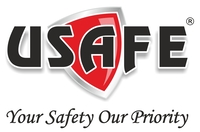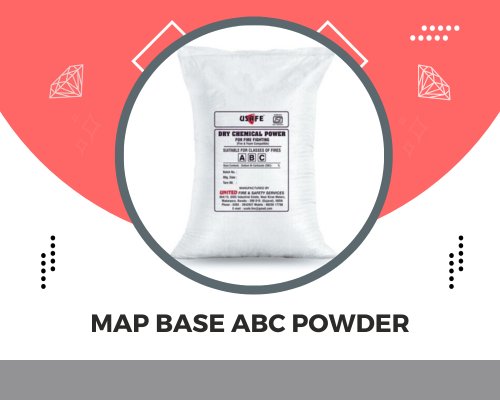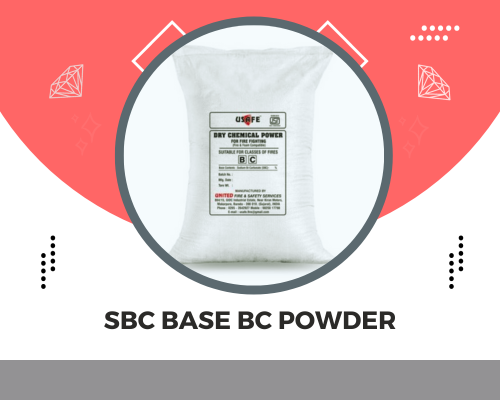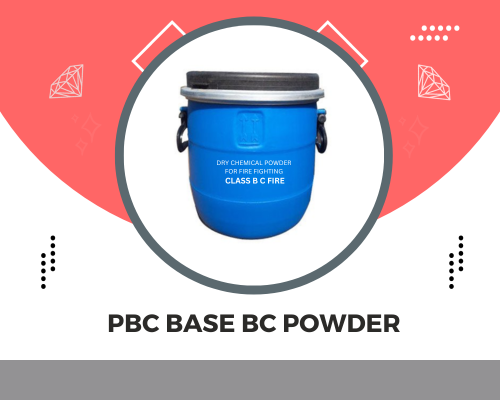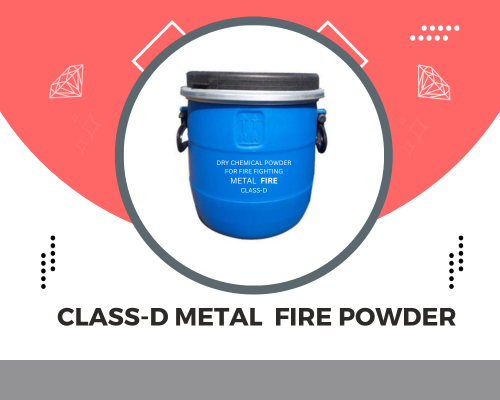
Dry Chemical Powder
We UNITED FIRE AND SAFETY SERVICES is a Leading Manufacturer Produces USAFE brand High-Quality ABC and BC Powder for Diverse Fire Suppression Needs.
DCP is short name of Dry Chemical Powder. Dry Chemical Powder is a widely used and necessary firefighting media for extinguishing various types of fire. It is fine siliconized powder that rapidly cool the fire and prevents to further spread. DCP Powder is most useful fire extinguishing agent which interrupts the chemical chain reaction of different types of Fires.
What are the main types of DCP Powder which is commonly used in Fire Fighting Applications?
There are four main types of DCP powder:
- MAP-based DCP powder: Mono ammonium Phosphate (MAP)-based DCP powder is also known as Multi-Purpose Dry Chemical Powder or ABC Powder. MAP powder is a yellowish color, non-toxic. It soothes the fire, preventing the release of flammable vapors by creating a thin layer on the fuel. It is a highly effective fire extinguishing agent and is suitable for combating class A, B, and C fires. MAP-based DCP offers excellent fire-knockdown capabilities therefore it is known for quick control and low re-ignition properties.
- Sodium bicarbonate (SBC): based dry chemical powder is a white, non-toxic powder which is used for firefighting of class B and C fires. Class B fires involve flammable liquids, such as gasoline, oil, and grease. Class C fires involve energized electrical equipment
- PBC-based DCP powder: Potassium Bicarbonate (PBC)-based DCP powder is often preferred by oil & gas Industries for its highly suppressing fires capabilities. It is mainly used for fires of flammable liquids, gases, and electrical equipment. PBC-based DCP is effective for tackling class B and C fires. It is non-conductive, so it is safe to use on electrical fires, and has the added benefit of being residue-free, minimizing post-fire cleanup.
- Metal Fire TEC Powder: Metal Fire TEC Powder is a specially made for extinguishing fires of flammable metals such as magnesium, sodium, titanium, and others. These metals can carriage unique fire hazards due to their high-temperature combustion characteristics. Metal Fire TEC powder forms a coating-like seal over the burning metal. It prevents the fire from scattering and reducing the risk of re-ignition.
Advantages of DCP Powder
DCP powder offers a number of advantages, including:
- Broad Spectrum uses in Fire Fighting: DCP powder is effective against different types of fires, including class A, B, C, and certain class D fires (with specific DCP variants). It can be used in portable fire extinguishers, fixed installations, and firefighting systems.
- Fast & Quick Fire Control: DCP powder acts quickly, suppressing fires and preventing their rapid spread.
- Non-conductive: ABC powders are often safe to use on electrical fires, making them a versatile firefighting agent.
- Low Residue: Some Dry Powder variants, such as PBC-based powder, leave minimal residue after use, avoiding extensive cleanup efforts.
Choosing the Right DCP Powder
When choosing the appropriate DCP powder, it is essential to consider the nature of the fire hazard. MAP-based DCP powder is a good all-around choice for most fire emergency situations. SBC-based DCP powder is ideal for suppressing fires involving flammable liquids and gases. PBC-based DCP powder is a good choice for fires involving flammable liquids, gases, and electrical equipment. Metal Fire TEC Powder is specifically designed for extinguishing fires involving flammable metals.
Frequently Asked Questions
What is dry chemical powder(DCP) and how does it work?
Dry Chemical Powder (DCP) as a superhero for putting out fires. This special powder is like a magic potion that can tackle fires caused by things like liquids, gases, or even electricity. It’s super versatile and can be found in different fire extinguishers.
Now, let’s talk about what makes this powder so amazing. Inside it, there’s a mix of powders, kind of like a secret recipe. Some ingredients are called monoammonium phosphate, diammonium phosphate, and sodium bicarbonate. These work together to stop the fire’s chemistry, basically shutting it down.
Here’s how our superhero, DCP, does its job:
- Cooling: The powder cools things down by soaking up the heat. This is crucial to stop the fire from flaring up again.
- Smothering: DCP covers the fire like a cozy blanket, keeping it away from the air. Fires need oxygen to keep going, so taking that away puts them out.
- Chemical Stopper: The special chemicals in DCP mess with the fire’s chemical reactions. For liquid and gas fires, it breaks the chain reaction that’s keeping the fire alive.
DCP extinguishers are like the all-in-one heroes. They’re great for tackling fires from liquids, electricity, or regular stuff that burns. But, a heads-up: after using DCP, there might be a leftover powder that can be a bit mean to metals, so it’s smart to clean up the affected stuff.
Remember, picking the right fire extinguisher is like choosing the right tool for a job. Know your fire types and grab the right extinguisher—safety first!
What is ABC(MAP-50%), potassium bi-carbonate, dry chemical powder and how does it work?
1. ABC Fire Extinguisher (MAP-50%):
ABC fire extinguishers are like superheroes for fires! They work on three types of fires – the ones from wood and paper (Class A), flammable liquids (Class B), and electrical fires (Class C). The “MAP-50%” thing means that half of the magic powder inside is Monoammonium Phosphate (MAP).
2. Potassium Bicarbonate:
A fire-fighting ingredient. It’s like a superhero sidekick, especially for fires in kitchens with hot oils and fats. We call it Potassium Bicarbonate, and it’s pretty good at stopping fires.
3. Dry Chemical Powder:
This is like the all-around hero powder. It doesn’t have a single recipe; it’s a mix of different powders, like Monoammonium Phosphate, ammonium sulfate, and others. The choice depends on what kind of fire you’re dealing with.
How they do their job:
ABC Fire Extinguisher (MAP-50%):
The magic powder messes up the fire’s chemistry party. It covers the fuel, stopping it from mingling with oxygen, and that’s how it stops the fire – like putting a lid on it!
Potassium Bicarbonate:
When things get hot, Potassium Bicarbonate releases a buddy called carbon dioxide. This buddy helps put out the fire and stops it from getting worse.
Dry Chemical Powder:
This powder makes a barrier between the fuel and oxygen, kind of like building a wall. It also sucks up the heat, making the fire go, “Oh no, I’m too tired for this!”
Remember, these superhero fire-fighters are awesome, but it’s crucial to use the right one. Using the wrong type might not work, or it could make things worse. Follow the safety rules, and pick the right extinguisher for the kind of fire you’re dealing with. Stay safe, hero!
What are the different types of dry chemical powder fire extinguishers?
1. ABC Fire Extinguishers
What they’re good for: These are like superheroes. They can put out fires from wood, paper, cloth (Class A), flammable liquids (Class B), and electrical fires (Class C).
Secret Power: Inside, they’ve got a special powder, kind of like magic dust. It’s usually blue.
2. BC Fire Extinguishers
What they’re good for: They’re like sidekicks. Great at stopping flammable liquid fires (Class B) and electrical fires (Class C), but not so much for wood and paper (Class A).
Magic Dust: Their powder is different, like using baking soda or a special salt. Look for the red ones.
3. Class D Fire Extinguishers
What they’re good for: These are the heroes for metal fires. Think of burning metals like magnesium, titanium, or stuff like that.
Special Magic Dust: Their powder is unique, maybe like salty or graphite stuff. Colors vary, but often yellow.
4. Metal-X Fire Extinguishers
What they’re good for: Just like Class D, but with a different kind of magic powder. Perfect for metal fires.
Secret Recipe: The powder inside can be a mix of special stuff. Look for different colors.
Remember, picking the right fire extinguisher is like choosing the right tool for a job. Always check the label and make sure it matches the kind of fire you’re dealing with. And hey, some extinguishers use a cool purple powder (“K” powder) – they’re great for putting out those sizzling cooking oil fires in kitchens!
